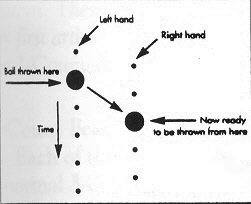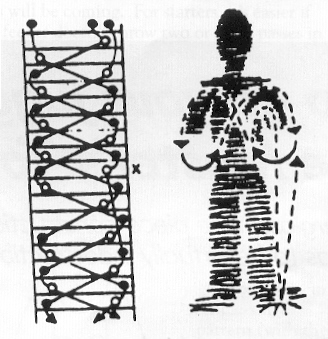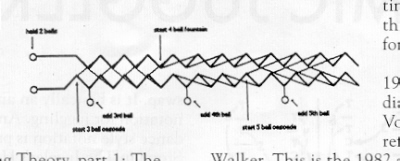|
THE ACADEMIC JUGGLER
The Invention Of Juggling Notations by Arthur Lewbel
JUGGLING NOTATIONS: The most useful contribution of academic analyses for jugglers so far is site swap notation and its extensions, which has lead to the creation of a new genre of juggling patterns. A full description of site swap notation is in the Summer 1991 Juggler's World article, "A Notation for Juggling Tricks. A LOT of Juggling Tricks," by Bruce Tiemann (Boppo) and the late Bengt Magnusson.
Site swap notation consists of a diagram showing the paths of balls among hands over time, and a string of numbers that concisely describe the diagram. Other contributors to the development of site swap theory include Jack Boyce, Allen Knutson, Ed Carstens, and jugglers on the computer network.
An extension to site swap notation that - deals with simultaneous and multiplex throws and catches is Carstens multihand notation (MHN). MHN is described in Ed's 1992 unpublished paper, "The Mathematics of Juggling," and in his computer program Jugglepro, which was recently reviewed in both Juggler's World and Kaskade (Jugglepro is available from Ed at Rolla, MO). Other juggling simulation software, some of which incorporate site swaps, include "the Juggler" by Bruce Love, "JUG - The Juggling Simulator" by David Greenberg, "The Juggling Video Task" by Anthony A.M. van Santvoord, "Juggle!" by Michael Kramer, "The 3 Ball Juggler" by John Gallant, and the site swap pattern generator by Jack Boyce.
The potential usefulness of a juggling notation for describing, remembering and inventing juggling tricks must have been obvious for a long time, especially before the advent of video. For example, sometime around 1972 Steve Mills saw Ron Lubman perform a 3 ball trick that was so intriguing that he dragged out a Super-8 movie camera to film it. By studying the film, Steve learned the trick, and improved it by continually reversing its direction. The result was the creation of Mills Mess. With cheap, convenient video, this process of learning from and improving recorded tricks is now commonplace and has contributed substantially to the current explosion in variety of juggling moves.
In searching through old juggling publications (a very pleasant pastime) the earliest published juggling notation I found is by Dave Storer, "A Written Notation for Describing Ball Juggling Tricks," In the IJA Newsletter (the publication that preceded Juggler's World), March-April 1978, vol. 30, # 2, p.7. Storer's notation is nothing like site swap. It is basically an analogy of music notation for juggling. Another music or dance style notation is proposed by B.W. Stone in The Juggler's Handbook, published in 1983 by Spiritwood Publishers in Minneapolis. Richard Dingman's 1984 self-published book, "Patterns," also contains a rudimentary non-site swap-related notation for club passing patterns.
The second oldest notation I found was a short article by Jeff Walker in the January 1982 Juggler's World. I'll come back to this one later.
Where did site swap notation originate? The first published reference to site swaps is in Tiemann and Magnusson's article "The Physics of Juggling," in "The Physics Teacher," 1989 pp. 584-588. They credit Paul Klimak with inventing it first, and say they reinvented it a short time later. They also mention the article by Charlie Simpson, "Juggling on Paper," in Juggler's World, Winter 1986, p. 31. This article contains the diagram that shows the paths of balls over time, and uses it to invent a few tricks that would now be called site swaps.
The diagram also appeared in Peter Jan Beek's 1989 Ph.D. thesis from Vrije Universiteit in Amsterdam, "Juggling Dynamics." Beek calls the diagram a "tonality ladder," and says he heard about it from Charlie Dancey, a former partner of the noted U.K. juggler Haggis. The diagram also shows up in Kaskade number 25, March 1992, in "Juggling on Paper" by Joachim Voigt, pp. 16-17 (note this is the same title as Simpson's article). Voigt's version has an extension for marking the type of throw in club juggling (e.g., number of spins). The diagram reappears in Kaskade #29, in "Workshop - Juggling Theory, part 1: The DAB Theorum (sic) and other serious illnesses" March, 1993, pp. 35-37, by JOTA (Jongliertheoretische Arbeitgemeinschaft). It is also mentioned (though not used) in Martin Probert's 1990 book, "491 Patterns for the Solo Juggler."
Another variant of the diagram, designed to show the length of time that hands spend full and empty, is in "Juggling Made Complicated" by Jack Kalvan. Jack's unpublished paper has many interesting results in it, including a calculation of the maximum permitted errors to avoid collisions in standard juggling patterns. Jack also worked on the now-defunct juggling robot project at IBM, and is half of the noted juggling duo Clockwork. (Although Jack and Rick Rubenstein didn't know it when they named themselves Clockwork, the name is reminiscent of how the Elgins, a Vaudeville juggling group, were named.
Elgin was the name of a watch manufacturer at the time. The group walked by a jewelry store that posted the ad, "Elgin: precision timing" and decided that was a good name for a juggling troupe).
So, did Simpson 1986 invent the 1 diagram? No. Both Voigt and Probert refer back to Jeff Walker. This is the 1982 article I skipped over above. It is "Variations for Numbers Jugglers," in the January 1982 issue of Juggler's World, page 11. This short article, less than one page, not only has the juggling diagram, but uses it to invent some site swap moves, contains the basic site swap idea of having, for example, a 5 denote a five ball cascade throw, and even has synchronous throw and multiplex tricks!
So Walker laid the groundwork for site swaps and MHN, but did he also invent the diagram? Perhaps, but around 1981 Claude Shannon began writing an article called, "Scientific Aspects of Juggling." It was supposed to appear in Scientific American, but he never finished it. After gathering dust for over a decade, it war finally published a few months ago in the book: "Claude Elwood Shannon Collected Papers," edited by N.J.A. Sloane and A. D. Wyner, New York: IEEE press, pp. 850-864. The paper has no site swaps, but there in figure 5 are three juggling patterns, depicted using the same diagram.
Interestingly, in every place the diagram appears except in Shannon's and Kalvan's articles, the diagram is drawn vertically with the time axis running from top to bottom. Only Claude and Jack followed the standard convention in physics and math of having the time axis run from left to right (thanks to Peter Beek for noticing this). Apparently, something clicked in the 1980's, causing the site swap diagram and notation to be independently rediscovered many times. In contrast, the 1990's are fast becoming the decade where the theory goes into practice, with jugglers everywhere learning how to perform site swaps. Remember when a 3 3 10 was a club passing pattern and not an illegal site swap for 5 1/3 balls? |






